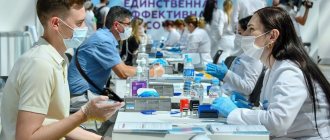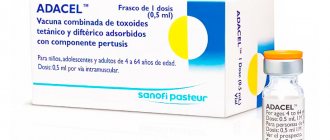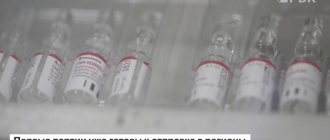18.12.2019
Interesting
Natalia Adnoral
To vaccinate or not to vaccinate? Each of us has the right to choose an individual way to protect ourselves and our children from diseases. It is important that this choice is conscious - based on knowledge of WHAT and WHY we are doing in the context of the current moment and long-term perspective.
Vaccines are not food, water or air that everyone needs, regardless of their condition. Vaccines are potent medications that necessarily have their pros and cons—indications and contraindications for a specific drug for a specific person at a specific point in time. It's important to know about them! Both to those who are going to be vaccinated and to those who offer this procedure.
The purpose of this article is not to advocate for or against vaccinations, but to provide necessary food for thought.
Let's look into the past. Vaccines were originally created as a life-saving treatment. And more than once this message justified itself. Especially in the 19th - first half of the 20th century. For example, people from different countries (including Russia) who had been bitten by rabid animals flocked to Louis Pasteur, the inventor of the rabies vaccine (against rabies), who lived in France. And those who managed to meet the two-week deadline survived thanks to the vaccine.
Edward Jenner, the inventor of the world's first vaccine (against smallpox), took thirty years to achieve his first experience of vaccinating a person (including his own son!), driven by the desire to save people's lives (at least a third of those infected died from smallpox) . Moreover, he came to the idea of artificial infection with cowpox as a means of countering the real disease purely empirically (by observing milkmaids who became immune to human smallpox after suffering a mild form of a similar cowpox disease), since at that time (in 1796) there was no talk about immunity, Moreover, viruses (smallpox is a viral infection) were not yet known.
Albert Calmette and Camille Guerin at the beginning of the 20th century worked to create an anti-tuberculosis vaccine (named in their honor BCG - “Bacillus Calmette-Guerin”) in order to protect children living surrounded by patients with this terrible disease, which at that time claimed many lives.
Since the 19th and early 20th centuries, vaccines have been both preventive (for example, smallpox and antituberculosis) and therapeutic (for example, rabies, tetanus). The purpose of their introduction was good - salvation from serious, deadly illnesses at the cost of a “minor illness” caused by the entry of a weakened or killed pathogen into the human body; its fragments or toxoids.
But, already at the dawn of vaccination, the results were not clear-cut. Success went hand in hand with failure (complications; illness from the disease for which they were vaccinated, but in an even more severe form, even death). And the reason is not only the contamination of vaccines with virulent strains, because even in our time of careful control over the purity of drugs, the danger of post-vaccination complications has become no less.
Why is the thesis “vaccinated means protected” not always confirmed in reality?
How vaccines work
What are vaccines?
These are immunobiological preparations, the main active principle of which is a modified pathogen (weakened, killed, represented by fragments or toxoids).
What are vaccines supposed to protect against?
From an infectious disease. What is its reason? Is it only in the entry of the corresponding pathogen into the body? Of course not. Otherwise, everyone infected would get sick. But this never happened even during terrible epidemics of plague, cholera, not to mention smallpox, tuberculosis, polio, diphtheria, influenza, etc. That is, in addition to the pathogen itself, no less a role in putting pressure on the “scales” of health -diseases (both in the sense of the very fact of the disease and the ability to cope with the disease) are played by internal factors, both congenital and acquired. Since the second half of the 19th century, they began to be called a very familiar term today - “immunity”.
Etymologically, this word means “liberation, getting rid of something.” Immunity (in relation to the infections we are considering) is essentially the innate or acquired ability of the body to protect itself and get rid of pathogens that have penetrated it. It is this ability that the vaccine introduced into the body is designed to create.
Now we come close to answering the third question.
What is the target of the vaccine?
That same “internal factor” is the immune system, which plays a decisive role in the development of the disease and its prognosis, and not the causative agent. The latter serves as a target for other “weapons” in the fight against infections - antibiotics or antiviral drugs. And if the pathogen is more or less universal (for a specific disease in a narrow time range), then the state of the immune system is very individual!
What does the vaccine do?
Changes the state of the immune system in order to acquire the ability to recognize and destroy a specific pathogen. The expected result is the body’s resistance/immunity to this infection (for a short or long term).
Will it be formed?
- Maybe yes.
- Perhaps, for one reason or another, the body is not able to produce it, and the introduction of the vaccine will not only not strengthen, but will worsen its condition.
- Perhaps it already exists, and there is no need for vaccination.
The actual outcome of vaccination depends not so much on the characteristics of the vaccine, but on the current state of the immune system (and other systems) of a particular person. Hence the variability in the effects of vaccination (with the same vaccines) in different people.
Differences between natural immunity and post-vaccination immunity
The differences in the formation of natural and post-vaccination immunity cannot be discounted. It’s not for nothing that the latter is often called “crutches.”
Natural immunity (with rare exceptions of infection directly through the blood) is formed in response to the penetration of the pathogen through the natural boundaries of the body with the external environment - the skin and mucous membranes. In response to an invasion, a cascade of reactions is triggered: recognition, memorization of the pathogen, development of protective measures “here and now” and for a long period of time with the gradual inclusion of cellular and humoral mechanisms of fast and slow action. As a result, we have stable, reliable, and most often lifelong protection.
Very important starting points are missing in the formation of vaccine immunity. Why? Because the vaccine most often (there are several vaccines that are administered through the mouth or nose) bypasses the “border posts”, entering directly into the blood (intramuscular administration is considered optimal by many). As a result, immunity is either defective or short-term, requiring repeated stimulation.
The result of artificial stimulation of the immune system can be its depletion, subsequently leading to the so-called. delayed post-vaccination complications: allergies, autoimmune diseases, chronic infections, cancer, etc. Or - to the development of acute or chronic forms of the disease for which they were vaccinated.
Natural infections that a child’s body becomes familiar with serve as a kind of “trainer” for his immune system. For example, there are studies that have shown that frequent contact of children with “kindergarten” respiratory infections reduces the risk of developing acute lymphoblastic leukemia by 30–40%! Other scientists have proven that people who have had measles in childhood are less susceptible to cancer and significantly less likely to die from cardiovascular diseases.
Another important point. Ideas about how natural and vaccine immunity arises are based on knowledge in this area of yesterday and today. But there is every reason to believe that this knowledge is very, very incomplete, and that the process of forming protection is much more complex and “multidimensional.”
For example.
The effectiveness of post-vaccination protection is assessed by the number of corresponding antibodies formed in response to the introduction of the vaccine (antigen). But there is evidence that a large number of antibodies does not always protect their owner from infection and the severe course of the corresponding disease. This is, firstly. And, secondly, there are children (and there are many of them) who are not capable of producing antibodies to the antigen introduced with the vaccine. For example, with respect to diphtheria toxin (one of the components of the DTP polyvaccine), the proportion of such children is 10–12 percent.
On the other hand, people who were born unable to produce antibodies (with so-called agammaglobulinemia; antibodies are immunoglobulin molecules) often remained healthy during direct contact with infections and/or were capable of forming lasting immunity in case of illness.
The answer to the question: what is better - artificial stimulation of the immune response or the natural process of its formation - can only be individual.
- For a specific child with specific characteristics of the immune system, living in specific conditions.
- Regarding a specific disease and the risks of contracting it.
- Taking into account the already known principles and stages of development of the immune system of the child’s body.
Vaccinated people were given two years: Is there a chance to survive after the vaccine?
The story of the ever-revealing consequences of Western vaccines continues and has even taken on new, even more frightening colors.
For example, the US regulator recently expanded the list of side effects of the Pfizer and Moderna vaccines to include possible heart problems. Pfizer has previously been discussed in connection with the occurrence of edema, allergies and even facial paralysis in vaccine recipients.
Joseph Mercola, a member of the Association of American Physicians and Surgeons, went further and even announced that the mortality rate from COVID-19 vaccinations exceeds the mortality rates from more than 70 vaccines combined over 30 years. And he even wrote an article about this with a lot of other stunning conclusions. Joseph Mercola’s “colleague,” American professor Peter McCullough, did not stand aside and said that in the United States, vaccines have replaced effective treatment for coronavirus. And all this is happening against the backdrop of cries from domestic liberals demanding that imported vaccines be “allowed” into our country... Experts from Russia assessed the situation.
Six thousand deaths due to a vaccine?
Joseph Mercola's article was published on LewRockwell. The author states that as of June 11, 2021, 358,379 adverse events (pain at the injection site, dizziness, etc.) after Covid vaccinations were registered in the United States. At the same time, the mortality rate was 5,993 cases, the American doctor emphasized.
As virologist, Doctor of Medical Sciences, Professor Anatoly Altstein , in order to talk about almost 6,000 deaths (!) due to the vaccine, it is necessary to have the conclusion of medical commissions.
“There is no reliable data here, so solid that one can say that six thousand of them actually died,” the professor clarified.
“Just the most common fake”
Joseph Mercola did not limit himself to the overwhelming lethality from vaccines in the United States and added fuel to the fire by talking about a conversation with doctor Vladimir Zelenko , who treated patients from coronavirus infection. Doctors have concluded that a person receiving a Western vaccine against COVID-19 may die from complications in the next two to three years.
To say that vaccinated people will die in two or three years does not fit into any corners, and there is not the slightest reason for this, this is just the most common fake,
– Anatoly Altstein emphasized.
The fact that a lot of people will die in two or three years is beyond doubt. Moreover, it is worth remembering that deaths occur, and this cannot be changed in any way, as a result of natural causes, the professor clarified.
“There are diseases, there are heart attacks, strokes, there are age-related changes, there are a variety of diseases, and so on. People die, it's natural. Therefore, indeed, many people will die, because such is human fate,” noted the doctor of medical sciences.
As for the effect of the vaccine on thousands of deaths, this is a pure fake, the virologist once again emphasized.
“Some of those vaccinated with the vaccine will also die. But not because he is vaccinated, but because the time has come, such is his fate. Someone might get hit by a car, someone might drown. The reasons may be different. The vaccine has absolutely nothing to do with it. There is no threat for a person to die because he was vaccinated with a vaccine,” says Anatoly Altshtein.
Time for "all evil spirits"
The chief physician of Moscow City Clinical Hospital No. 71, Alexander Myasnikov, responded to the Americans’ statements in his own manner. According to the doctor and TV presenter, now is the time when “all evil spirits are raising their heads.”
“Joseph Mercola is a well-known anti-vaccine activist. He has not been a doctor for a long time, he writes books... He has been consistently fighting against vaccines for a long time, participating in television shows,” explained Alexander Myasnikov.
Doctor of Medical Sciences Dmitry Edelev also noted that Joseph Mercola is one of the most famous anti-vaxxers in the United States.
“He is passionately opposed to vaccines, so he is not always able to say what really is. Health problems, in fact, judging by the American report of December 10 last year, arose in the form of local manifestations in 77% of those vaccinated. In the form of general manifestations (severe headache, severe weakness, loss of performance, and so on), problems arose in half of those vaccinated. Every fourth vaccinated person developed a high temperature,” explained the doctor of medical sciences in a conversation with Tsargrad.
Have they “replaced” treatment with vaccines?
But according to American Peter McCullough , at one time the US authorities ignored recommendations for early and effective treatment of COVID-19 in favor of vaccination. Meanwhile, the same mysterious technique (including, by the way, the use of rejected hydroxychloroquine...), which could not be put into practice, would have reduced the number of hospitalizations by 85%, but met persistent “resistance at all levels,” McCullough explained.
All this, according to the doctor, is aimed at promoting mass vaccination. However, we are talking about experimental drugs with unknown consequences, he clarified, emphasizing that vaccines represent the “second phase” (after Covid itself) of the introduction of biological weapons. Hence the deaths of thousands of people who could have been prevented without “replacing” COVID-19 treatment with vaccines, Daily Expose reports.
Candidate of Medical Sciences, Associate Professor of the Department of Microbiology and Virology at Yaroslavl State Medical University Andrei Tsvetkov commented on the “explosive” revelations of American doctors.
You can say whatever you want, but it is quite difficult to prove the exact outcome associated with the introduction of the vaccine. It is necessary to go through entire stages of consultations, research or even judicial proceedings in order for this to be proven,
– says Andrey Tsvetkov.
“It’s not the vaccine that protects”
The specialist reasonably noted that only time will tell how the vaccination affects the body, clarifying that one should not forget about the individual characteristics of the body.
“The side effects from the vaccination, including what complications there were now, are associated mainly with the action of this adenovirus, and not with its vectorial influence on the human genome by introducing some foreign region. This will not appear soon. Everything will appear later, later. Here we will analyze something - statistics, vaccinated, unvaccinated. Time should always show this,” Andrei Tsvetkov emphasized.
The candidate of medical sciences also drew a parallel with the flu.
“With whomever I discuss the topic of influenza, all the doctors say with one voice: yes, we ourselves were vaccinated, we vaccinated everyone, and for many years we have seen very simple statistics: everyone got sick and still gets sick. Both vaccinated and unvaccinated,” the expert noted.
That is, it turns out like this: whoever has not had the flu will not get it after vaccination. And those who have had the flu will continue to get sick even after vaccination and without it.
It is not the flu vaccine that protects people who are not sick. They: Well, I did it and I’m not sick. You haven’t been sick before... Therefore, if a person is not sick, it means that everything is fine with him, there is no need to rebuild anything. He leads a correct lifestyle, nutrition, hardens himself, everything goes as usual for him, and he does not need the intervention of either viruses or bacteria. In this regard, vaccination is considered strictly individually, we need to look at all these groups,
– the specialist concluded.
Superior to Russian vaccines... with side effects
Although in his material the same Joseph Mercola does not indicate which vaccines the people included in the sad statistics were vaccinated with, it is known that in the United States and the European Union the Pfizer/BioNTech and Moderna vaccines are mainly used.
An even more depressing picture, as follows from Joseph Mercola’s article, is observed in Europe. According to EudraVigilance, as of June 19, 2021, there were 1,509,266 adverse reactions from vaccines, including 15,472 deaths. The doctor notes that the database accepts reports only from EU countries, and therefore contains information on only 27 of the 50 European countries. In this case, we are obviously talking not only about Pfizer/BioNTech and Moderna, but also about the Anglo-Swedish AstraZeneca vaccine.
Therefore, the new trick of home-grown domestic liberals, demanding that imported vaccines be “allowed” into Russia, looks scary. Especially against the backdrop of the fact that foreign vaccines are being persistently imposed on the whole world, trying to prove their superiority over drugs from Russia. This suggests the conclusion that “our” liberals can simply work for Western employers.
It is worth recalling the position that Russian President Vladimir Putin . Thus, vaccination against coronavirus infection should be voluntary, and coercion, especially if there are contraindications, is unacceptable.
Features of the immune system in children
1. The immune system of a newborn child is NOT MATURE! Its maturation duration coincides with the entire period of childhood.
But this does not mean that the baby born is absolutely defenseless against external aggressors. At first, its main defense is maternal molecules (immunoglobulins), transmitted to the baby in utero and continuing to enter his body during breastfeeding. It is not without reason that the latter serves as the most effective disease prevention measure for infants.
2. The process of active development of the child’s immune system goes through several critical periods:
- the first month of life (0–29 days) - passive protection of the baby by maternal antibodies; your own defense mechanisms are still very imperfect;
- 4–6 months - the “validity period” of passive protection ends and the active formation of your own begins;
- the second year of life - a sharp increase in the variety of contacts with the outside world against the background of still insufficient internal security;
- the sixth to seventh year of life and adolescence (12–15 years) - active changes in the functioning of the immune system, temporarily increasing the body’s susceptibility to certain infections.
These periods are called “critical” because at this time the child’s immune system is most sensitive and capable of unpredictable reactions in response to a foreign agent (antigen) entering the body.
Their comparison with the vaccination calendar (easy to find freely available online) shows that many vaccines (antigens) are introduced into the child’s body precisely during periods of maximum vulnerability of its defense system. This is especially true for vaccinations in the first hours (vaccine against hepatitis B), in the first days (vaccine against tuberculosis - BCG) and in the first months (vaccine against whooping cough, diphtheria, tetanus - DTP; vaccine against polio, etc.) of a baby’s life.
Necessary conditions for vaccination
Let us repeat, a vaccine is a potent drug, the prescription of which requires strong indications and, STRICTLY, the absence of contraindications for each individual person. Especially for a child. And three times especially for a newborn. Most of those who are called “anti-vaxxers” are not against the idea of vaccines, but against their mass, thoughtless use, since numerous studies have shown that such an approach has not been justified.
Yes, some diseases are almost a thing of the past (for example, smallpox). But the winner’s laurels in these cases are ready to share with vaccines a number of other social, sanitary-epidemiological and therapeutic measures (improving the quality of food and water, the appearance of sewage systems, refrigerators and personal hygiene products; the invention of antibiotics, etc.).
Other diseases, for example, tuberculosis, on the contrary, despite mass vaccination in maternity hospitals (BCG), are confidently regaining their lost positions. So confident that currently in Russia there are tens of times more cases of tuberculosis than in countries where newborn children are not vaccinated with BCG.
Why doesn't the protection work? Perhaps because:
- 99 percent of children do not need such a vaccination at all. They are immune to tuberculosis even without it.
- In some of the remaining 1% susceptible to this disease, the vaccine may trigger the development of the so-called. “vaccine-associated” tuberculosis in severe form (it can manifest itself both immediately and years after the vaccine is administered). Children with a weakened immune system (with so-called primary and secondary immunodeficiencies) are at particular risk.
Moreover, the risk of post-vaccination complications leading to chronic illnesses, including disability and death, is present in ALL children with immunodeficiencies (as well as fermentopathy and other genetic diseases), and not only in those who are constitutionally sensitive to the causative agent of tuberculosis.
Only a preliminary special examination - genetic screening and determination of the immunological status of newborns - can identify such problems and protect children from harm. Only on the basis of its results can an individual decision be made for and against the introduction of certain vaccines. Do we conduct such an examination before the first vaccination? As a rule, no.
Genetic (neonatal) screening is carried out after the first vaccination (at least hepatitis B; often also BCG). Determining immune status is not at all included in the mandatory examinations of newborns. It turns out that the role of “screening” (“selection, sorting”) of children with a weakened immune system is played by the vaccinations themselves (which are clearly contraindicated for such children). The result is severe complications.
It is for this reason that many doctors and scientists are opposed to mass vaccination without prior examination.
Vaccination PROS and CONS
Good afternoon. I would like to highlight another topic that raises quite a lot of questions: vaccination. It is known that life expectancy in the Middle Ages was quite low, no more than forty years, and the cause of mortality was mainly infectious diseases. Currently, mortality from infectious diseases has decreased significantly. It makes up 23% together with toxic poisoning and consumption of any substances. And the reason for the decrease in mortality is still vaccination.
The first vaccination was carried out in 1780 in the form of inoculation - that is, the introduction of the contents of a pustule (a cavity filled with pus) of a smallpox patient into a cut in the skin of a healthy person. And a decrease in morbidity and mortality was noticed. But history knows the facts of the extinction of entire cities from smallpox.
Vaccination began to actively develop only in the 20th century. And during this time, the incidence of many serious diseases, such as measles, rubella, polio, and tuberculosis, has significantly decreased. But at present, there is still debate among people and among doctors about the benefits and necessity of vaccine prevention. Vaccines come in different types - live, killed, as well as fragments of bacteria or viruses, so-called antigens. Modern vaccines are of fairly good quality, purified. And in pediatric practice, polyvalent vaccines (containing more than one type of antigen) are now used: penta, sexta vaccines. And it is believed that such vaccines can be administered to a small patient.
How does the vaccine act on the body? When our blood encounters an antigen, our immune system produces protective antibodies. The immune response remains in the body for some time. And for different vaccines, different periods of re-vaccination have been developed. That is, the time during which antibodies can leave the body. If in the future such an organism encounters an infectious agent, the ready-made antibodies are activated and begin their work against this agent and at the same time transmit information to other lymphocytes about the properties of this agent. And thus the immune system is activated very quickly.
What if, for example, there are no such antibodies? It takes about two days to produce them. And this time is very critical for the body: there is a high temperature and complications may develop.
I had to see a blood test after a flu vaccine on the fifth day. There is a redistribution of cells inside leukocytes, our protectors, the number of lymphocytes increases due to the decrease in other cells. As a matter of fact, you see such a blood test very often in healthy people. That is, there is a constant war going on in the body. Someone is constantly encountering an infection. These could be sick children at home, sick colleagues at work. And our immunity is on guard. He constantly monitors this infection and develops antibodies against it. Thus, nothing terrible and nothing special happens in the body during vaccination. And it is believed that the average time for antibody production after vaccine administration is about fourteen days.
The question is often asked that after the administration of a vaccine some kind of viral disease develops. But the flu is not to blame here, and the vaccine is not to blame. Apparently, the vaccination was done when an infectious agent of a different nature, a common viral infection, was already in the body, and the administration of the vaccine distracts the immune system and weakens its grip on the former agent, so the smoldering ARVI worsens.
Another example. You've probably often wondered why doctors don't get sick? After all, therapists encounter infections many times during their working day. Infectious disease specialists, one might say, live at work, they are even on duty there, and even more so pediatricians, because children are our main carriers of infections. They spread it both in their environment and in the family, passing it on to adults. I think the whole point is that short-term contact with various types of infection leads to the production of antibodies in the doctor’s body, and therefore the doctor is protected. Of course he might get sick. If, for example, at this moment the doctor is overworked, under stress or in some other unfavorable situation, or has been, for example, on call at home for a fairly long time with a large contact of infection. Therefore, in general, no one is insured, but the fact that vaccination protects is a fact.
Online consultation with a pediatrician (consultation on vaccinations)
consultation cost: 500 rubles
Online consultation
During the consultation, you will be able to voice your problem, the doctor will clarify the situation, interpret the tests, answer your questions and give the necessary recommendations.
There is a lot of controversy now, mainly about influenza vaccination. I remember 2009, 2010, when there was a very serious flu in Lipetsk - A H1N1 - and there were deaths in Lipetsk. And after that conclusions were drawn. And currently, enough funds are allocated in Russia as a whole for influenza vaccination.
Each vaccination is accompanied by the issuance of orders. So, in the order, the first place in vaccination against influenza is given to pregnant women from the second and third trimester and their entourage. Nursing mothers can also be vaccinated. Next come people suffering from chronic diseases. Such as oncology, bronchial asthma, diabetes. Children of the first year of life, simply elderly people over sixty years old. And in last place are all the others working. Thus, sufficient attention is paid to flu vaccination in our country, and this turns out to be economically justified. Days of incapacity for work are decreasing, and hospitalizations due to influenza are decreasing.
Influenza is dangerous not because of the disease itself, but because of the development of complications. People die from influenza pneumonia or from the development of acute heart failure, and it can be almost impossible to do anything about it; a person burns out in two days. And since the vaccine is very well tolerated, wouldn’t it be easier to prevent this disease? If a person gets sick, it will be in a milder form, because we don’t know in what situation we will come into contact with an influenza infection. Maybe at that moment we will be tired or in some kind of stressful state.
I would also like to highlight one such detail - in the nineties we lost the vaccine prevention system. Or rather, the system exists, but thanks to the media, we have had some tendency for mothers to refuse to vaccinate their children, and thus, a certain non-immune layer has formed in our community. And these healthy people, healthy children, not having antibodies to certain infections, can cause harm to those children for whom vaccination is contraindicated for some medical reasons. For example, these may be weakened or premature, or allergic children, those who are currently not being vaccinated, but they will get sick by contact with those healthy ones who will only be cultivators of this infection, its carriers.
You can give a couple more examples. In 1992, we had an outbreak of diphtheria in Russia. At that time, vaccination against diphtheria was weakened; we simply did not carry it out. Or another example: now, in recent years, there have been outbreaks of measles. And measles is mostly imported. The world is now an open space. People move around a lot. And they come to us, and we go. It is unknown where, what infection, what carrier we may encounter both on the plane and in another country. Therefore, in my opinion, it is better to vaccinate. Opponents may say that immunity is not always formed in one hundred percent of cases, there may be post-vaccination complications, but believe me, this is such a low figure compared to all economic feasibility that it is probably still worth listening and protecting yourself and your child.
For me personally, the issue of vaccination has never been an issue. I have always followed the epidemiological instructions - doctors must be vaccinated. Ours also follows this. We have an excellent vaccination department on the fourth floor of the Children's Health Center. We purchase high-quality imported vaccines, we maintain a cold chain (storage and transportation system ensuring optimal temperature conditions). Welcome to visit us for vaccination.
Unsafe components in vaccines
Various preservatives and adjuvants are components that increase immunogenicity (the ability to provoke an immune response) - another unsafe “unknown” in the “equation” of “vaccinated means protected.”
- Not only are these components antigens that can provoke a violent reaction in the body with short- and long-term consequences.
- Some of them, for example - mercury salts, formaldehyde, phenol, ethylene glycol (antifreeze), aluminum hydroxide - are also very toxic. (The composition of specific vaccines of domestic and foreign production can also be found on the Internet).
Vaccine manufacturers argue that their safety is based on very small doses of these substances. But we will not tire of repeating: the body’s reaction to certain substances and the dependence of its severity on the dose is very individual! It is not for nothing that even the 2021 vaccination calendar indicates the category of people for whom vaccines that do not contain preservatives should be used. But preservatives do not include, for example, aluminum hydroxide (found in the hepatitis B vaccine, which is administered intramuscularly on the first day of a child’s life).
The same genetically engineered vaccine against hepatitis B, widely used in maternity hospitals, also contains yeast. For most kids there is nothing dangerous about them. But there are babies who are at high risk of developing a severe allergic reaction. Is such a study carried out in the first hours after the birth of a child?
What diseases are vaccinated against?
There are many vaccines available in modern medicine.
Some types of vaccines are considered mandatory and are included in the vaccination calendar, others are given during epidemiological outbreaks.
BCG
This first and most important vaccine is given in the maternity hospital. It protects the newborn from infection with tuberculosis.
Due to the anatomical features of the respiratory system of babies, any respiratory diseases are extremely dangerous for them. This is why it is so important to protect the child from the first days of life.
Hepatitis B
The next routine vaccination is against hepatitis B. This is one of the most serious diseases, which is subject to long-term treatment with a low percentage of favorable outcomes. You can encounter it everywhere, even in a regular dental office.
Tetanus
The causative agent of this disease is found in the soil, in dog feces, and on rusty metals. Enters the body through the blood. The child often falls, gets scratches, abrasions, so there is a high chance that during the next fall the tetanus bacteria will still enter the body.
With the bloodstream, the microbe enters the nervous system, causing severe convulsions. The most dangerous is a spasm of the respiratory muscles, which leads to suffocation and death. During attacks, due to strong extension of the spine, you can get multiple injuries with subsequent disability. There is no cure for the disease, and the number of survivors is extremely small; as a rule, they are profoundly disabled.
Doctor's advice
There are cases when vaccination of children causes complications; this cannot be predicted. However, a negative reaction can occur to any drug or food product, detergent, or even new clothes due to dye. Every day, thousands of people turn to doctors with allergic manifestations of varying severity, even coma due to various reasons. Terrible diseases can only be prevented by administering a vaccine; each parent who has written a waiver of this procedure bears responsibility for the health of the child.
Victoria Druzhikina Neurologist, Therapist
Whooping cough
An extremely serious disease characterized by spasmodic paroxysmal coughing up to respiratory arrest. The older a person is, the easier he tolerates this infection.
In adults, whooping cough is most often completely asymptomatic, but for infants this disease is very dangerous. A child may simply suffocate during coughing attacks.
Diphtheria
It is accompanied by severe intoxication of the body and inflammation of the organs of the respiratory system with the formation of a filmy coating on them, which blocks the airways and leads to suffocation.
This is especially significant for infants, who have such small lumen sizes in the upper respiratory tract that any formation can cause serious harm to health.
It is almost impossible to remove these films due to their dense fusion with tissues. The slightest attempts to tear off plaque lead to severe pain and the formation of bleeding wounds on the mucous membrane.
Polio
Multiple lesions of the gray matter of the brain with the subsequent development of paresis and paralysis of those parts of the body that innervate the affected area of the nervous system.
Measles
It is dangerous not so much because of the disorders caused by the virus as because of the complications of the disease. These include croup (larynx stenosis), measles pneumonia, central nervous system lesions, and lymphadenitis.
Rubella
Dangerous complications on the reproductive system. It poses a particular threat to a pregnant woman who is unvaccinated and has not had rubella in childhood. Causes multiple deformities of the fetus, and in early pregnancy - miscarriage. If a pregnant woman is infected with rubella, an abortion is performed for medical reasons.
Mumps
It often causes complications in the urinary system with damage to the kidneys, affects the functioning of the pancreas, and also causes infertility.
Among the unscheduled vaccines, vaccinations are carried out against certain strains of influenza virus, meningococcal infection, adenovirus, typhoid fever, smallpox, cholera, and plague.
Pneumococcal infection
Pneumococcus is the most common cause of community-acquired pneumonia at any age. In children under three years of age, pneumonia is especially dangerous due to the structure of the respiratory tract and can be fatal. This vaccination forms the development of immunity against pneumococcus, i.e. when encountering a real pathogen, the body will have the means to fight it and pneumonia will not develop. Included in the list of mandatory requirements in 36 countries, incl. – in the USA and Europe. In the Russian Federation, it was included in the National Vaccination Calendar (the main guideline for vaccination of the population of all ages) in 2014. Before this, it was carried out at the request of the parents. The vaccinations are called “Prevenar”, “Pneumo 23”, “Pneumovax 23”.
They differ in manufacturer, cost and age from which use is permitted. "Prevenar" is used in children from 2 months, because promotes the development of immunity against 7 subspecies of pneumococcus, the rest - from 2 years, after their administration, immunity to 23 types of microorganisms is formed.
Complex vaccines
For example, MMR is a vaccine against measles, mumps and rubella; pentaxim - against diphtheria, tetanus, whooping cough, polio and hemophilus influenzae.
Their effectiveness and safety have been questioned by many scientists and doctors due to the following observations:
1. Under natural conditions, a person never suffers from several infections at the same time.
2. One of the components of the vaccine can provoke the formation of an incomplete immune response to its other component. For example, the rubella component of the complex MMR vaccine reduces the effectiveness of measles protection.
3. Simultaneous introduction of several live (weakened) pathogens into the body (for example, as part of the same COC) significantly increases the risk of complications (for example, inflammatory bowel disease).
Why vaccinate children?
Because vaccinations protect the baby from terrible diseases, the consequences of which can be death or disability for life. Vaccines introduce the baby’s immune system to extremely weakened or even dead pathogens and train it to fight these dangerous enemies. As a result, after each vaccination, a new detachment of immune special forces is formed in the child’s body, ready to deal not only with a “training” infection, but also with a real infection.
In addition to personal immunity, vaccination forms collective immunity to contagious (transmitted from person to person) diseases. Thanks to this interesting effect, when several infectious carriers of the infection appear in a population, it does not spread due to the low probability of their meeting with unvaccinated people. Herd immunity allows those who cannot be vaccinated for medical reasons to remain healthy. And, most importantly, your baby until the age when he can undergo routine vaccination. Here's how it works:
How herd immunity works.
Thanks to mass vaccination, it has been possible to completely eradicate some diseases in individual countries or even on a global scale. In 1980, the World Health Organization (WHO) declared the complete eradication of smallpox throughout the world, and now the causative agent of this most dangerous disease has been preserved only in medical research laboratories.
Finally, according to WHO and the United Nations Children's Fund (UNICEF), vaccination against just four diseases - diphtheria, tetanus, whooping cough and measles - saves up to 2.5 million lives every year. In our opinion, this argument alone is enough to once and for all close the debate about the benefits of vaccinations.
conclusions
The purpose of the above facts is not to belittle and denigrate the very idea of vaccinations as a way of protecting against suffering and death. Vaccinations may well act as an individual therapeutic drug (for example, anti-rabies or anti-tetanus). Or as a reasonably necessary means of prevention for healthy people going on a trip (to areas rich in infections that are unusual for us). There may be other individual arguments in favor of vaccination. Moreover, science does not stand still, and as our knowledge about the functioning of the immune system grows and the system of pre- and post-vaccination control improves, the effectiveness and safety of new vaccines will increase.
The purpose of the above facts and thoughts is to encourage people to think and pay special attention to the following points:
- mass vaccination of newborns and infants;
- vaccination of children without justified, individual need and mandatory availability of a genetic passport and immunological examination results;
- vaccinating children without prior parental consent (especially in maternity hospitals!);
- vaccination of children with live vaccines (BCG, DTP, polio, measles, rubella, mumps);
- use of vaccines containing toxic components;
- simultaneous administration of several vaccines;
- intimidation and other elements of economic and psychological pressure on people (both those being vaccinated and those vaccinating);
- the need to provide complete information about the pros and cons of vaccination, possible complications, the rights of parents to refuse vaccinations and its consequences, about alternative methods of preventing and treating diseases.
Yes or no to vaccinations? The choice is yours. The main thing is that it is yours - conscious and voluntary!
How to separate the truth and myths about vaccinations?
In short, any argument in favor of refusing vaccinations other than for individual medical reasons is a myth. But let’s look at the “hot seven” arguments of anti-vaccinators in more detail.
Myth 1. Many diseases do not require vaccination. They are only a consequence of poor sanitary conditions, so they disappeared in developed countries by themselves.
Yes, such diseases do exist, but not on the vaccination schedule. Diphtheria, measles, mumps, chickenpox and other dangerous diseases were common in dirty medieval cities, but they also feel great in modern cities. The anti-vaccination movement in Great Britain, Sweden and Japan in the 70s of the last century led to outbreaks of whooping cough with hundreds of thousands of cases of the disease in these quite sanitary countries.
This misfortune did not spare us either. In the 1990s, against the background of mass refusal to vaccinate, a diphtheria epidemic occurred in the countries of the former USSR, as a result of which more than 150 thousand people fell ill and more than 5 thousand people died.
Myth 2: Pharmaceutical companies lobby for vaccinations to make extra profits.
How many times does a person get vaccinated in his life? And how many take pills, give injections, apply ointments, buy medications on their own and implicitly pay for them from their health insurance? In 2010, WHO estimated the share of vaccine sales in the pharmaceutical industry's turnover at only 2-3%. So convincing people to get vaccinated is not a good business strategy. They generate income, but not nearly as fantastic as anti-vaxxers believe.
Myth 3. Vaccines are dangerous to health. Many children who fell ill or died in infancy had been vaccinated several days or weeks earlier.
Any mathematician will immediately understand what is wrong with this statement. And he himself will compose a lot of similar ones. For example: many people who have been injured on ice had brushed their teeth within 24 hours prior. Or this: many motorcyclists involved in accidents used the Internet several hours before the accident. All these statements contain two parts: the first describes a random event, and the second speaks of regular, characteristic actions. And they are not connected to each other in any way.
The first year of a baby’s life is full of vaccinations, and, regardless of this, is a period of risk for SIDS (sudden infant death syndrome). But this is nothing more than a coincidence: doctors do not consider vaccinations to be the cause of SIDS and have proven this more than once. Moreover, studies even show a decrease in the number of sudden infant deaths as vaccination coverage increases.
Myth 4. Vaccines place an increased burden on a fragile child’s body, and this is dangerous to health.
Immediately after birth, the child’s immune system is faced with a huge amount of pathogenic microflora. And, according to the most conservative estimates, it is capable of simultaneously coping with thousands of new viruses. Even complex vaccines, such as DTP or MMR, cannot put too much stress on the baby’s immune system.
Myth 5. The safety of vaccines is questionable due to their aluminum and mercury content.
These metals are contained in microscopic quantities in vaccines and are actually needed there. Recently, in order to dispel consumer doubts, manufacturers have been removing components that cause concern from the composition of drugs. For example, the mercury-containing preservative thimerosal was excluded from some vaccines, and then a study was conducted to determine how its presence or absence affects the baby’s health. It turned out that there is no difference.
Myth 6: Vaccines cause autism.
This myth even has a specific author - British gastroenterologist Andrew Wakefield. In 1998, he wrote an article in which he argued that the MMR (measles, mumps, rubella) vaccine can cause autism in a child. It soon became clear that Wakefield was sponsored by an anti-vaxxer organization, and the findings of his “research” were influencing people to buy a biological test produced by a company co-owned by Wakefield.
The point is not only that the author of the scandalous material hid his interest in the panic around MMR. The lack of connection between vaccination and autism has been convincingly proven by many studies.










